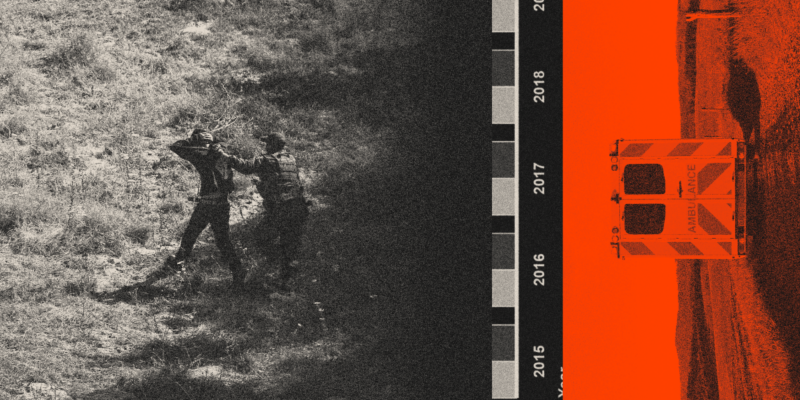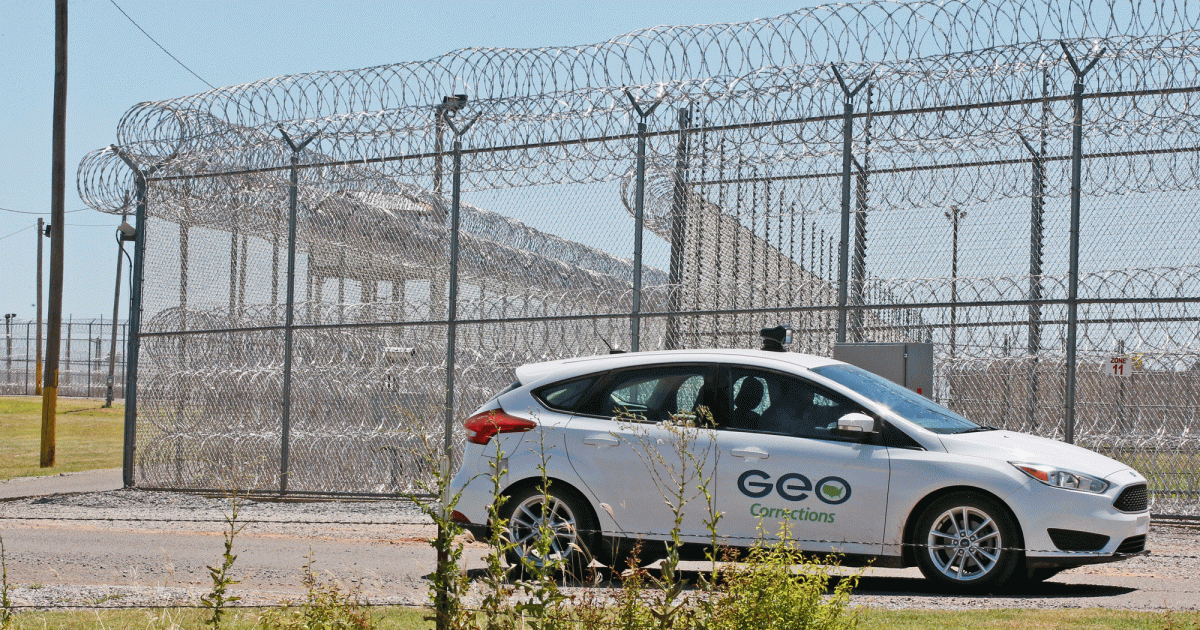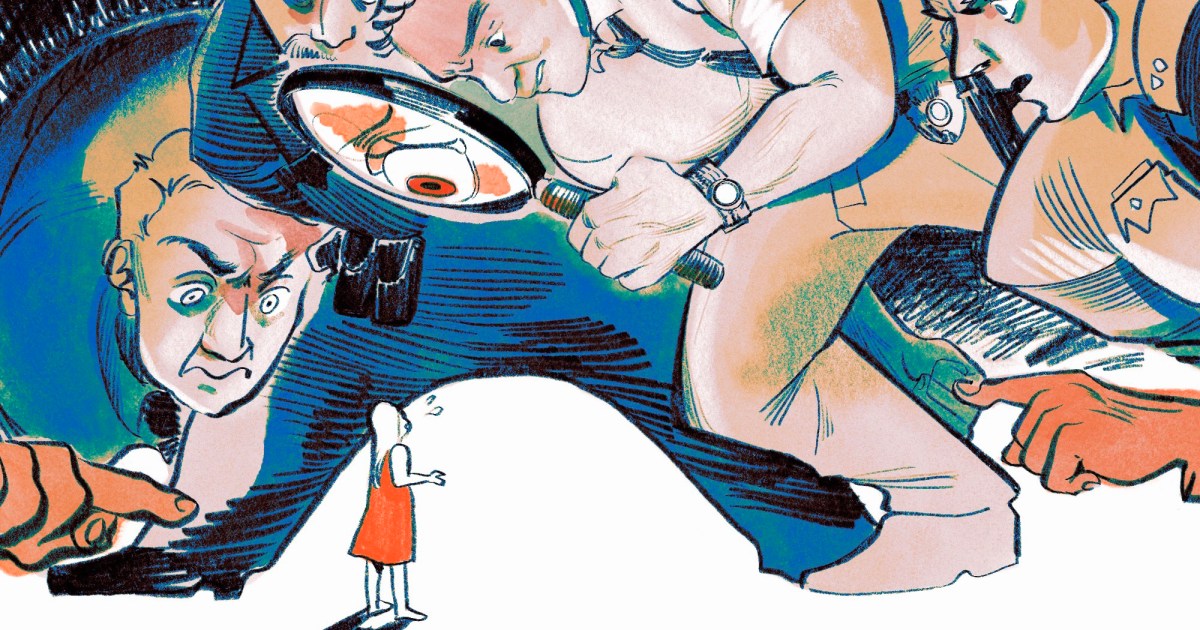
For six days, a man we’ll call Martín walked across a remote stretch of the Sonoran Desert between Mexico and southern Arizona with a guide and six other migrants. It was February 2023, and the nights were frighteningly cold. One morning, he awoke to the desert painted white—the first time he had seen snow. They walked and walked. It snowed again, and they kept walking—until Martín couldn’t walk anymore.
Three months earlier, the 23-year-old had left his home in Guatemala’s western highlands. A father of three, Martín (whose name has been changed to protect his identity) had never finished elementary school, and good jobs were hard to come by. So he did what so many others from his region have done: He headed north, hoping to cross the border undetected and find better opportunities in the United States.
Martín’s journey ended on a hillside in the Baboquivari Mountains, 26 miles north of the US-Mexico border. When he began suffering chest pains and stopped to rest, the group continued without him, leaving him with a gallon of water and no food. High on the mountain, his cellphone had enough service to call 911. He kept calling—11 times in total over the ensuing three days. But help never came from official channels—not from the Pima County Sheriff’s Department, which has a team of search and rescue deputies, or the US Border Patrol, which has specialized search and rescue–trained agents. Instead, upward of 14 volunteers initiated a chaotic three-day mission to rescue Martín. In their multiple attempts to reach him through locked gates and terrain too punishing to navigate, one question kept surfacing: Why had the agencies tasked with rescue work along the world’s deadliest migration route failed to act? Why had they left this man to potentially die on a mountain?
Martín’s case is just one example of how the search and rescue system in the borderlands often fails migrants caught up in the US’s decadeslong efforts to deter unauthorized migration. It is symptomatic of a scattershot emergency response system with little accountability, in which responsibility for saving migrants’ lives is divided among Border Patrol agents whose primary duty is law enforcement, not search and rescue; overtaxed county search and rescue teams; and unpaid volunteers from humanitarian groups who take it upon themselves to come to migrants’ aid when no one else will. The result is a system in which stranded migrants like Martín can fall through the cracks—sometimes with deadly consequences.
Migrants crossing the Southwest border have faced particularly perilous conditions since the 1990s, when the Border Patrol began implementing an immigration enforcement strategy known as “prevention through deterrence,” which closed off popular crossing points near urban ports of entry, pushing migrants into more remote parts of the Sonoran Desert. In theory, the harsh natural environment of the desert was supposed to discourage unauthorized migration. But instead of deterring migrants, these policies only made the journey more dangerous—a reality that even the Border Patrol could not ignore. From the mid-1990s, when the prevention through deterrence policies were implemented, to 2005, the number of migrant deaths approximately doubled, with the majority of the increase occurring in the Border Patrol’s Tucson, Arizona, sector, which includes a large swath of the Sonoran Desert.
The federal government created a search and rescue training program called BORSTAR in 1998. Since then, the Border Patrol has conducted thousands of rescues along the Southwest border: In 2022, agents rescued 22,075 people, up from 12,857 in 2021 and 5,336 in 2020. That increase partly reflects overall trends in migration—border crossings surged after 2020 in large part due to Title 42, a Trump administration policy that immediately expelled migrants seeking asylum at the border, prompting more repeat crossings. It also reflects improved search and rescue infrastructure in the borderlands: Cellphone coverage has expanded in some remote parts of the Sonoran Desert, and the Department of Homeland Security has invested more money into resources like rescue beacons and placards instructing migrants to call 911 if they are in trouble. Despite these investments, migrant deaths have remained high. The Border Patrol recorded 895 deaths along the Southwest border in 2022, compared with 568 in 2021 and 254 in 2020. Given that the Border Patrol has long struggled to collect complete data on migrant deaths, those numbers are likely a significant undercount.
Martín’s call for help came from a remote corner of Pima County, which sees the majority of migration-related distress calls in the Sonoran Desert, averaging four to five per day. Throughout the US, county sheriff’s offices are typically responsible for providing search and rescue services for anyone in their jurisdiction, a norm codified under Arizona state law. But unlike neighboring Cochise and Yuma counties, which respond directly to migrants calling in distress, dispatchers at the Pima County Sheriff’s Department refer all calls they suspect are migration-related to the Border Patrol—a practice that critics allege is discriminatory and results in an often-substandard emergency response.
Pima County has significant resources at its disposal to respond to those calls, including seven dedicated search and rescue deputies, the volunteer-run Southern Arizona Rescue Association, helicopters, infrared cameras, drones, and a trained canine team. But according to Deputy Adam Schoonover, a public information officer for the Pima County Sheriff’s Department, the Border Patrol can respond faster to lost or injured migrants in remote parts of the borderlands. “It’s all about getting the person help as quickly as possible and that has many variables to it,” he said in an email, noting that the department’s search and rescue deputies often are out on a call and may be unavailable. “BORSTAR units can respond faster and are well equipped to handle calls for service in the border area.”
The data, however, often suggests otherwise. A recent investigation by Tanvi Misra for High Country News and Type Investigations found that of the 3,000 emergency calls handled by the Border Patrol’s Tucson sector in 2022, 38 were categorized as medical emergencies, but only six appeared to have triggered a search and rescue operation. Another 299 callers routed to the Border Patrol were never found.
In the absence of a reliable emergency response from local law enforcement and the Border Patrol, an informal network of volunteers with local nonprofits has for years been navigating the difficult and dangerous work of conducting search and rescue operations themselves.
The call came at 1 p.m. to the hotline run by an Arizona humanitarian aid group: A man’s brother was stranded somewhere on the US side of the border and needed help. It was Martín’s brother calling. After Martín had called 911 and no one had come for him, he tried his brother, who lives in the US and knew about the hotline. The hotline dispatcher called the Border Patrol, as is the group’s protocol, and relayed the information about Martín, including his location. Hours later, the hotline dispatcher received another call from Martín’s brother. Martín was still out there, his brother said. “Didn’t you call Border Patrol? What’s going on?”
The dispatcher passed the case to the Frontera Aid Collective (FAC), another group that conducts search and rescue missions and water drops along the border. Taylor Leigh and Scott Eichling, two FAC volunteers, decided to mobilize immediately to try to rescue Martín. It was 9 p.m., and as Leigh got ready, she called the Border Patrol, “freaking out,” she said. Temperatures were already below freezing, and Martín had been out there for a night and a day.
As Leigh and Eichling loaded supplies into the FAC vehicle, Leigh was transferred five times to different Border Patrol stations. She finally reached an agent, who she said told her that the Border Patrol couldn’t do anything about Martín. Eichling called back and got the same response from that agent. He called again and said another dispatcher laughed at him.
Although the Border Patrol often touts the existence of BORSTAR and a more recent initiative called the Missing Migrant Program as proof of its commitment to providing search and rescue services, the reality is more nuanced. The agency’s Missing Migrant Program, which began in 2017, was responsible for installing the thousands of 911 signs and more than 170 emergency beacons along the border to facilitate rescues, but many migrants in distress are reluctant to use them until the situation is dire, knowing that contacting the Border Patrol will lead to arrest and deportation. Not only that, neither BORSTAR nor the Missing Migrant Program are independent entities with dedicated personnel to help migrants in distress.
Rather, the Missing Migrant Program is a set of protocols governing how the agency responds to 911 calls from migrants and families inquiring about loved ones who have gone missing while trying to cross the border. For instance, agents first check whether the missing person is in the custody of US Customs and Border Protection, the Border Patrol’s parent agency, before instructing a family to call their consulate for more information (as agents are typically barred from providing direct information on specific cases to civilians).
Similarly, BORSTAR is not the equivalent of a dedicated search and rescue team, ready to mobilize for any emergency call. Rather, it is a relatively tiny initiative, employing roughly 300 agents spread out among the nine Border Patrol sectors along the Southwest border. Essentially, BORSTAR agents are regular Border Patrol agents with specialized training: They attend a five-week BORSTAR Academy, where they learn various search and rescue skills and become certified emergency medical technicians. Despite that training, they actually spend most of their time out in the field performing regular enforcement duties.
Calls from or about lost or injured migrants forwarded to the Border Patrol by 911 dispatchers or humanitarian groups are first categorized and assessed for their urgency, then forwarded to the local Border Patrol station with details like GPS coordinates or a last known location. Rescues—which the Border Patrol also conducts for lost or injured US citizens—are handled by individual stations and often are collaborative endeavors among BORSTAR agents, regular Border Patrol agents, and Air and Marine Operations, another branch of Customs and Border Protection that deploys the helicopters and small planes patrolling the Southwest border, which can also be used for search and rescue. Occasionally, the Border Patrol will also ask local officials for assistance.
“Unless you have family who’s advocating for you and is really good at calling a million people, you’re kind of screwed.”
According to Steven Davis, a former volunteer with Pima County’s Southern Arizona Rescue Association who now volunteers with the humanitarian group the Tucson Samaritans, the Border Patrol does, in theory, have more search and rescue resources than Pima County, particularly in the remote regions of the border where people tend to run into trouble. The problem, he said, is their response is hampered by a lack of personnel to conduct large ground searches. And the Border Patrol is seen primarily as a law enforcement organization. “People often won’t call until it’s too late,” he added.
Leigh echoed Davis’ observations. “Border Patrol is supposed to send out BORSTAR—or just whatever agents are in the field—to go help somebody,” she said. “But it seems like that doesn’t really happen very often or effectively. Unless you have family who’s advocating for you and is really good at calling a million people, you’re kind of screwed.”
I asked Robert Daniels, a public affairs specialist for the Border Patrol, how the agency decides whether to respond to someone in distress. He denied that the Border Patrol ever declines to initiate a rescue. “We don’t do that,” he said, emphasizing that no one deserves to die crossing the desert. “We don’t tell somebody that they’re too far away, that we can’t get to them. If we can’t get to them on the ground, then we’re going to fly.”
When Daniels did not respond to further calls and questions about Martín’s case, I reached out to another public affairs specialist, who spoke to me on background, reiterating that the Border Patrol will always respond to a call for help but that the agency does triage calls. If the person isn’t injured, has food and water, and is in no immediate danger from weather conditions, the Border Patrol might wait to initiate a rescue. “You’re not going to send agents up a mountain overnight in order to get somebody, or fly an aircraft into the mountains to get somebody, when they’re perfectly content and capable of being walked down the next morning,” the specialist said.
That night, Leigh and Eichling drove south on State Route 286, a lonely two-lane highway that leads to the border. As the darkened mass of the Baboquivaris blotted out the skyline ahead, the magnitude of what they’d set out to do began to set in. Leigh and Eichling turned down a ranch road, but they kept running into locked gates, blocking their way forward. It was past midnight and they were alone on private property, so they decided to turn back. Another rescue effort that night mounted by members of the Phoenix-based Abolitionists aid group, along with another FAC duo, also proved unsuccessful. Martín would spend his second night out in the cold.
In the morning, Leigh and Eichling set out again with two other FAC members, having finally identified a better route up the mountain where Martín lay. They reached a locked gate. A tense discussion ensued; one volunteer was nervous about trespassing and risking arrest. Kyle Richardson, another FAC member, was adamant they continue. “We’re not going to let this abstract law get in the way of saving him,” Richardson said. The group dismantled part of the gate to get through.
Soon, the road grew so rough that they had to abandon their vehicle and walk down the private ranch road. Past a creepy-looking abandoned cabin, they finally came to a cattle tank at the base of the canyon that led up to Martín. There, they saw a Border Patrol agent sitting in his truck.
Leigh explained what they were doing, and the agent pointed to the mountain in front of them. Martín, he said, was “just on the other side.”
“Why aren’t you going up to him?” Leigh asked. The agent told her that his orders were to stay put. According to the Border Patrol public affairs specialist I spoke with, Border Patrol dispatchers initially had trouble locating Martín, and it was dark by the time they were able to establish contact. “We determined that he was stable and didn’t need immediate evacuation,” the specialist said, before acknowledging that humanitarian aid groups and Martín’s family might not have agreed.
The group headed up the canyon. Between them and Martín lay 4 to 5 miles of dense brush and boulders. The terrain was so steep that at times they had to climb on their hands and knees. A helicopter whirred in the distance and they saw it approach, assuming it had come to rescue Martín. Instead, it hovered near the top of the mountain where they were aiming for 20 seconds and then flew away.
After five or six hours, they reached a grassy saddle between two peaks. They crawled under a barbed-wire fence and walked along the trail, calling Martín’s name. Finally, they heard him. A faint yell in the distance, and then again.
When they reached him, he was lying in the middle of a bare grassy hillside, extremely dehydrated and in the early stages of shock. Richardson was struck by how visible he was—his black faux leather jacket and personal belongings scattered around him stuck out vibrantly against the light green backdrop.
The mood was somber as they slowly made their way back down the steep canyon, Eichling piggybacking Martín when he grew too weak to walk. Martín and his family had scraped together the equivalent of about $16,000 to pay for the journey in the hope that he would make it to the US and find work. Instead, once they reached the Border Patrol agent at the bottom of the mountain, he would be deported.
In the year and a half since Martín’s rescue, volunteers in southern Arizona and along other parts of the border have continued to mount search and rescue operations for migrants, some of whom had called 911 and been transferred to the Border Patrol multiple times, but received no response. There was the woman who called for help deep in the Ironwood Forest National Monument, 25 miles northwest of Tucson. To try to find her, FAC volunteers drove on some of the worst roads they had seen in the middle of the night, far from cell service. She had moved, so they never found her, but two days later, workers on a ranch did. She was nearly dead, but they brought her to a hospital and she survived. And a few weeks after FAC rescued Martín, a 23-year-old woman, also from Guatemala, called for help from the Baboquivari Mountains. Like Martín, her family had called 911 with her exact coordinates more than 60 times, but according to Leigh, every time, the dispatcher would say, “Not Spanish,” and hang up. Frantic, the woman’s family called the hotline for help. When volunteers located the woman, she had already died.
It’s difficult to know how many cases like these never received a response. A report from another humanitarian group, No More Deaths, audited 911 calls in Pima County from June 2022 and found that of 64 emergency cases received by the county and transferred to the Border Patrol during that month, there were 17 in which the distressed person was never located. In at least 10 of those cases, the Pima County Sheriff’s Department took no further action upon learning that the Border Patrol had not found the 911 caller.
“They have been tasked with stopping an ‘invasion’ at the border. In reality, they’re interacting with people who need basic aid, who need their asylum applications processed.”
The Border Patrol does not disclose how many emergency calls it receives or fails to act on, or the outcome of its search and rescue efforts. This lack of transparency and accountability in efforts to reduce migrant deaths has been well-documented for decades. In 2006, the federal government’s watchdog, the Government Accountability Office, issued a report that found that the Border Patrol’s efforts to reduce migrant deaths could not be fully evaluated due to insufficient data. The report also pointed out that the Border Patrol’s primary role as an enforcement agency often occurred simultaneously with its search and rescue activities, making it difficult to assess their efficacy. More recent GAO reports on the Missing Migrant Program have found that its recordkeeping on migrant deaths has long been incomplete and that Customs and Border Protection has not been transparent about disclosing those data limitations to Congress, though its data collection efforts have improved in recent years.
Reece Jones, a political geographer at the University of Hawaii who has written extensively about the Border Patrol, attributes the agency’s unreliable response to migrants in distress to a disconnect between its mission and the actual needs it encounters at the border. “They have been tasked with stopping an ‘invasion’ at the border,” he said. “In reality, they’re interacting with people who need basic aid, who need their asylum applications processed.” In the years since 9/11, when the agency’s mission was reframed around terrorism, the Border Patrol has grown increasingly militarized, Jones said. That militarization has only exacerbated the conflict of interest between enforcing border policies and reducing the death toll created by those same policies. “The Border Patrol hired Rambo when they needed Mother Teresa,” Jones said, paraphrasing journalist Garrett Graff. “That’s essentially the problem that’s happened over the last 20 years.”
When I last spoke to Martín, he was back in his hometown, struggling to find a job. What he wants most, he told me, is the opportunity to buy a house and give his children a better future. After what happened to him, Martín has no immediate plans to cross the border again. But he has entertained other possibilities. He had heard that adults who arrive at the US-Mexico Border with their children to seek asylum, handing themselves over to the Border Patrol directly, faced an easier pathway into the United States. “Maybe it will be better with one of my children,” he told me. “Maybe I would do it.”
Last November, I drove with members of FAC along a section of the border wall near Sasabe, a town straddling the border. Hundreds of migrants—many of them young children—had been arriving there, climbing through holes in the wall or walking across the border where the wall ends. They would wait for hours and sometimes days for Border Patrol agents to pick them up so they could claim asylum, a legal right under US and international law. That day, we came across two groups of 100 people or more, waiting in the shade of the wall. Twenty-five-year-old Sharon Mishell Valderramos had traveled 20 days with her son, Esquin, a smiley 6-year-old wearing a tie-dye baseball cap. “The government doesn’t protect us,” she said, when I asked her why she had left. All she wanted was to work and for Esquin to get an education.
A few miles west of Sasabe, the border wall ends in a canyon known colloquially as Smuggler’s Canyon. No fence exists there, just trails crisscrossing an invisible line in the scrubby desert, where a child’s jacket hung from a bush next to the trail. I thought of how Martín had left open the possibility of another journey north, this time with his children, and what might happen if they needed help.















